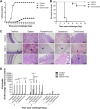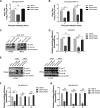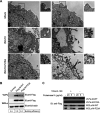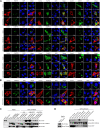Mutation of Phenylalanine 23 of Newcastle Disease Virus Matrix Protein Inhibits Virus Release by Disrupting the Interaction between the FPIV L-Domain and Charged Multivesicular Body Protein 4B
- PMID: 36695580
- PMCID: PMC9927168
- DOI: 10.1128/spectrum.04116-22
Mutation of Phenylalanine 23 of Newcastle Disease Virus Matrix Protein Inhibits Virus Release by Disrupting the Interaction between the FPIV L-Domain and Charged Multivesicular Body Protein 4B
Abstract
The matrix (M) protein FPIV L-domain is conserved among multiple paramyxoviruses; however, its function and the associated mechanism remain unclear. In this study, the paramyxovirus Newcastle disease virus (NDV) was employed to study the FPIV L-domain. Two recombinant NDV strains, each carrying a single amino acid mutation at the Phe (F23) or Pro (P24) site of 23FPIV/I26 L-domain, were rescued. Growth defects were observed in only the recombinant SG10-F23A (rSG10-F23A) strain. Subsequent studies focused on rSG10-F23A revealed that the virulence, pathogenicity, and replication ability of this strain were all weaker than those of wild-type strain rSG10 and that a budding deficiency contributed to those weaknesses. To uncover the molecular mechanism underlying the rSG10-F23A budding deficiency, the bridging proteins between the FPIV L-domain and endosomal sorting complex required for transported (ESCRT) machinery were explored. Among 17 candidate proteins, only the charged multivesicular body protein 4 (CHMP4) paralogues were found to interact more strongly with the NDV wild-type M protein (M-WT) than with the mutated M protein (M-F23A). Overexpression of M-WT, but not of M-F23A, changed the CHMP4 subcellular location to the NDV budding site. Furthermore, a knockdown of CHMP4B, the most abundant CHMP4 protein, inhibited the release of rSG10 but not that of rSG10-F23A. From these findings, we can reasonably infer that the F23A mutation of the FPIV L-domain blocks the interaction between the NDV M protein and CHMP4B and that this contributes to the budding deficiency and consequent growth defects of rSG10-F23A. This work lays the foundation for further study of the FPIV L-domain in NDV and other paramyxoviruses. IMPORTANCE Multiple viruses utilize a conserved motif, termed the L-domain, to act as a cellular adaptor for recruiting host ESCRT machinery to their budding site. Despite the FPIV type L-domain having been identified in some paramyxoviruses 2 decades ago, its function in virus life cycles and its method of recruiting the ESCRT machinery are poorly understood. In this study, a single amino acid mutation at the F23 site of the 23FPIV26 L-domain was found to block NDV budding at the late stage. Furthermore, CHMP4B, a core component of the ESCRT-III complex, was identified as a main factor that links the FPIV L-domain and ESCRT machinery together. These results extend previous understanding of the FPIV L-domain and, therefore, not only provide a new approach for attenuating NDV and other paramyxoviruses but also lay the foundation for further study of the FPIV L-domain.
Keywords: CHMP4B; ESCRT machinery; FPIV L-domain; M protein; Newcastle disease virus; virus release.
Conflict of interest statement
The authors declare no conflict of interest.
Figures







Similar articles
-
HRS Facilitates Newcastle Disease Virus Replication in Tumor Cells by Promoting Viral Budding.Int J Mol Sci. 2024 Sep 19;25(18):10060. doi: 10.3390/ijms251810060. Int J Mol Sci. 2024. PMID: 39337546 Free PMC article.
-
Mutations in the FPIV motif of Newcastle disease virus matrix protein attenuate virus replication and reduce virus budding.Arch Virol. 2014 Jul;159(7):1813-9. doi: 10.1007/s00705-014-1998-2. Epub 2014 Jan 30. Arch Virol. 2014. PMID: 24477785
-
Ubiquitination on Lysine 247 of Newcastle Disease Virus Matrix Protein Enhances Viral Replication and Virulence by Driving Nuclear-Cytoplasmic Trafficking.J Virol. 2022 Jan 26;96(2):e0162921. doi: 10.1128/JVI.01629-21. Epub 2021 Oct 27. J Virol. 2022. PMID: 34705566 Free PMC article.
-
The regulation of Endosomal Sorting Complex Required for Transport and accessory proteins in multivesicular body sorting and enveloped viral budding - An overview.Int J Biol Macromol. 2019 Apr 15;127:1-11. doi: 10.1016/j.ijbiomac.2019.01.015. Epub 2019 Jan 4. Int J Biol Macromol. 2019. PMID: 30615963 Review.
-
Membrane budding and scission by the ESCRT machinery: it's all in the neck.Nat Rev Mol Cell Biol. 2010 Aug;11(8):556-66. doi: 10.1038/nrm2937. Epub 2010 Jun 30. Nat Rev Mol Cell Biol. 2010. PMID: 20588296 Free PMC article. Review.
Cited by
-
The CRM1-dependent NES257-266 motif in the matrix protein: another factor influencing Newcastle disease virus propagation and virulence.Vet Res. 2025 Jul 1;56(1):126. doi: 10.1186/s13567-025-01552-6. Vet Res. 2025. PMID: 40598613 Free PMC article.
-
HRS Facilitates Newcastle Disease Virus Replication in Tumor Cells by Promoting Viral Budding.Int J Mol Sci. 2024 Sep 19;25(18):10060. doi: 10.3390/ijms251810060. Int J Mol Sci. 2024. PMID: 39337546 Free PMC article.
-
The multifaceted interactions between pathogens and host ESCRT machinery.PLoS Pathog. 2023 May 4;19(5):e1011344. doi: 10.1371/journal.ppat.1011344. eCollection 2023 May. PLoS Pathog. 2023. PMID: 37141275 Free PMC article. Review.
-
Insights into the function of ESCRT and its role in enveloped virus infection.Front Microbiol. 2023 Oct 6;14:1261651. doi: 10.3389/fmicb.2023.1261651. eCollection 2023. Front Microbiol. 2023. PMID: 37869652 Free PMC article. Review.
References
-
- Pentecost M, Vashisht AA, Lester T, Voros T, Beaty SM, Park A, Wang YE, Yun TE, Freiberg AN, Wohlschlegel JA, Lee B. 2015. Evidence for ubiquitin-regulated nuclear and subnuclear trafficking among Paramyxovirinae matrix proteins. PLoS Pathog 11:e1004739. doi:10.1371/journal.ppat.1004739. - DOI - PMC - PubMed
Publication types
MeSH terms
Substances
LinkOut - more resources
Full Text Sources

